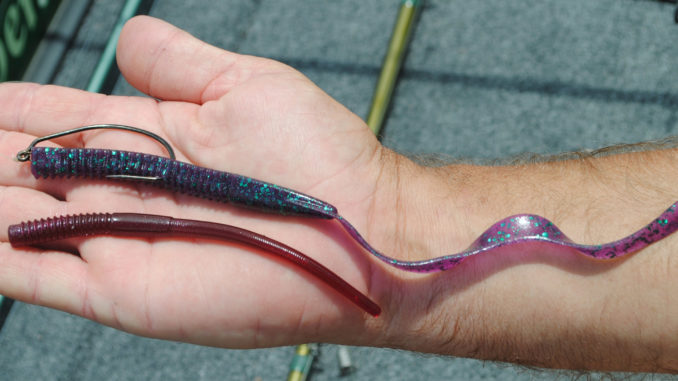
Summer is time to pick up a super-sized worm
I talk a lot during the year about baits I like to throw, like a Mop Jig — and I’ve always got one tied on — but a bait that’s very effective during the summer, especially when it comes to catching big fish, is a big worm.
When it’s hot, I like to fish a big, long snake like the 11-inch Trigger-X Hammer worm. I’ve got the same mindset about a plastic worm as I do a jig. You can catch bass on a small jig or a big jig, and you can catch bass on a small worm or a big worm, but the odds of catching a big fish are just better on a big jig or a big worm. It’s got a bigger profile — which is especially important when you’re fishing at night — and big fish just like to eat a big meal without having to expend much energy.
Another thing that makes a big worm so effective is that you can fish it through all kinds of cover, and bass are really cover- and shade-oriented during the summer. A big worm is heavy enough to sink down through all the limbs in a brush pile or through heavy grass, and it’s always a great bait to fish around docks. You can throw it on any kind of cover we’ve got in our lakes.
I like to Texas-rig a Hammer worm on a 5/0 or 6/0 Owner hook. The size of the sinker depends on the depth I’m fishing. If I’m fishing it in shallow lily pads or grass, I’ll throw it with an eighth-ounce sinker. If I’m fishing out deeper, in open water, I might use as much as a 3/8ths- or half-ounce bullet weight.
One thing I’d like to emphasize is that I don’t use a big worm as a search bait. It’s definitely a deal that you use when you’ve already found fish. I fish one if I’m fishing a particular brush pile or set of stumps or a place where I’ve already found fish with a crankbait. Those are the kinds of places I’ll fish a big worm. If you’re on a good place offshore and you think you’ve caught all the fish on a spot with a crankbait, then you throw a big worm in, a lot of times you’ll catch another one, and it will be a nice one.
For summertime fishing, I’m partial to three colors: red shad, junebug and green pumpkin; they’re all great colors. I’ll fish red shad at night or when I’m in darker or stained water. Junebug will work anytime; it’s a great summer color. Green pumpkin is a great summertime color, and it’s a good color to fish anytime you’re around vegetation.
I fish a big worm on a 7-foot, medium-action All-Star baitcasting rod. I like to spool up with 15- to 17-pound Trilene 100-Percent Fluorocarbon.
I also fish a big worm a little different than a lot of fishermen. Most people will just drag a big worm around, but my favorite way to fish it is to hop it up off the bottom and let it glide back down — the way you hop a jig. It’s real important to watch and see how the worm falls, because most of your bites are going to be when it’s gliding back down after you’ve hopped it off the bottom. Most people don’t pay close enough attention when their bait is falling; you’ve got to look for the line to jump or move a little to the side, because it’s hard to feel a bump when it’s falling on slack line.
One thing you need to guard against is making too long a cast. You’ve got that big worm and that big sinker, and you can cast it a mile, but that isn’t really what you want, because you’ll have trouble setting the hook with that much line out and that big a piece of plastic to drive the hook through. What you want to be doing is making medium-length casts and throwing it at specific spots, so if a big bass picks it up, you’ve got the leverage you need to make a good hookset and put that fish in the boat.
So dig through your tackle box and pull out the biggest worms you can find and put them to good use this month.






Be the first to comment